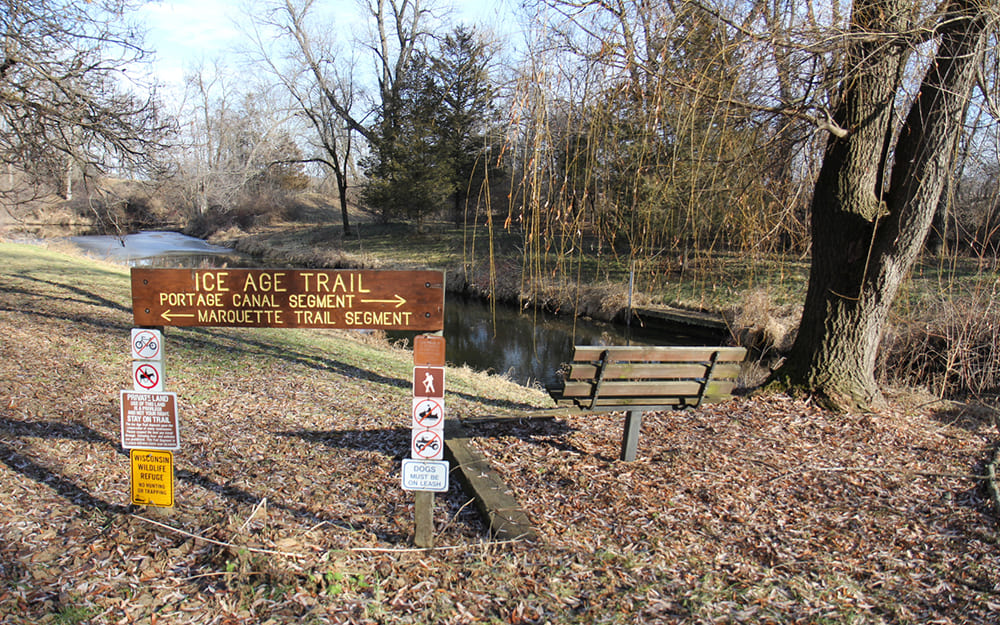Did you know that the Ice Age Trail in Delafield, WI 53018 spans a remarkable 65 miles, highlighting Wisconsin’s glacial landscapes that date back over 12,000 years? As you tread the same path once roamed by Ice Age creatures, you’ll encounter geological marvels such as moraines, kettles, and eskers. The trail offers a serene retreat from modern life, taking you on a literal journey through time, a testament to the Earth’s shaping powers. Its array of flora and fauna add another layer of intrigue. But what makes this trail a must-visit for both nature lovers and history enthusiasts?

Exploring the 65 Ice Age Trail
Venturing into the 65-mile stretch of the Ice Age Trail in Delafield provides you with a unique, immersive experience into Wisconsin’s glacial landscapes and history. As you tread the winding path, you’ll find yourself tracing the footsteps of Ice Age creatures that roamed this land over 12,000 years ago.
You’ll get a chance to explore the rich tapestry of Wisconsin’s geological history, etched into the dramatic moraines, kettles, and eskers that dot the landscape. Each feature tells a story, a testament to the power of the glaciers that once covered this land. You’re not just walking a trail; you’re journeying through time, witnessing firsthand the mighty forces that shaped the Earth.
The trail isn’t just a history lesson, though. It’s also a call to freedom, a chance to escape the hustle and bustle of daily life. You’re free to wander at your own pace, breathe in the fresh air, and soak in the tranquil beauty of the natural surroundings. The Ice Age Trail in Delafield doesn’t just offer a walk; it offers an adventure, an opportunity for self-discovery, and a unique insight into the stunning legacy of our planet’s past.
Flora and Fauna Highlights
Immersing yourself in the Ice Age Trail’s stunning landscapes, you’ll discover a diverse array of flora and fauna that breathe life into this ancient, glacial terrain. As you traverse through the trail’s ever-changing terrain, you’ll encounter towering oak savannas, vibrant prairies, and dense forests home to countless species of plants, birds, and mammals.
Each season brings a unique palette of colors and wildlife interactions. In the spring, wildflowers such as trilliums and violets burst forth, while warblers and thrushes fill the air with their songs. You might spot white-tailed deer grazing or red foxes darting through the undergrowth. Summer brings an explosion of prairie grasses and wild lupine, with monarch butterflies flitting amongst the blooms. In the fall, the foliage turns a breathtaking array of reds, oranges, and yellows, creating a spectacular backdrop for your hike.
For those with a keen eye, you’ll spot signs of the smaller creatures too. Look out for the intricate web of a woodland spider, or the busy work of ants and beetles. Every step you take on the Ice Age Trail introduces you to a new chapter in this vibrant ecosystem, offering unrivaled opportunities to connect with nature in its purest form.
Hiking Preparation and Safety Tips
While appreciating the diverse ecosystems along the Ice Age Trail offers a rich, immersive experience, it’s equally important to adequately prepare and prioritize safety for your hiking journey. You’ll want to start by checking the weather forecast to ensure you’re dressed appropriately for the conditions. Layering your clothing is key, as it offers flexibility for changing temperatures.
It’s also essential to carry a map and compass or GPS, as the trail can be challenging to navigate in certain areas. Don’t rely solely on your smartphone, since service can be spotty.
Ensure to pack enough food and water for your trip. Dehydration or hunger can quickly turn a fun hike into a dangerous situation. It’s also wise to carry a basic first-aid kit to handle minor injuries.
Avoid hiking alone if possible, but if you must, inform someone of your plans and estimated return time. Keep a steady pace and rest when needed. Remember, hiking isn’t a race.
Lastly, always respect the trail and its wildlife. Stay on marked paths, keep noise to a minimum, and don’t litter. A safe, enjoyable hike on the Ice Age Trail is all about preparation and respect for nature’s rules. Stay safe and enjoy your adventure!
Historical Significance of the Trail
The Ice Age Trail holds a unique place in Wisconsin’s history, revealing a fascinating geological past that’s ready for you to explore. This thousand-mile footpath, one of only 11 National Scenic Trails in the U.S., is a testament to the power of the last Ice Age. It’s a living museum, exhibiting the effects of glaciation.
Each step you take on the trail is a journey back in time, tracing the edge of a glacier that retreated 12,000 years ago. Along your hike, you’ll encounter kettles, moraines, and drumlins — all landforms sculpted by the glacier’s advance and retreat. These features aren’t only geological marvels, they’re also historical landmarks, providing clues to the past climate and environment of the region.
The trail’s historical significance isn’t limited to geology. It’s also been a route for Indigenous peoples for thousands of years and has witnessed the evolution of Wisconsin from wilderness to farmland to urban development. This trail is your pathway to freedom, a chance to explore Wisconsin’s history and natural beauty, unshackled from the restrictions of modern life. So, lace up your boots and step into Wisconsin’s past.
A great place to also visit is: St. John’s Northwestern Academies, WI